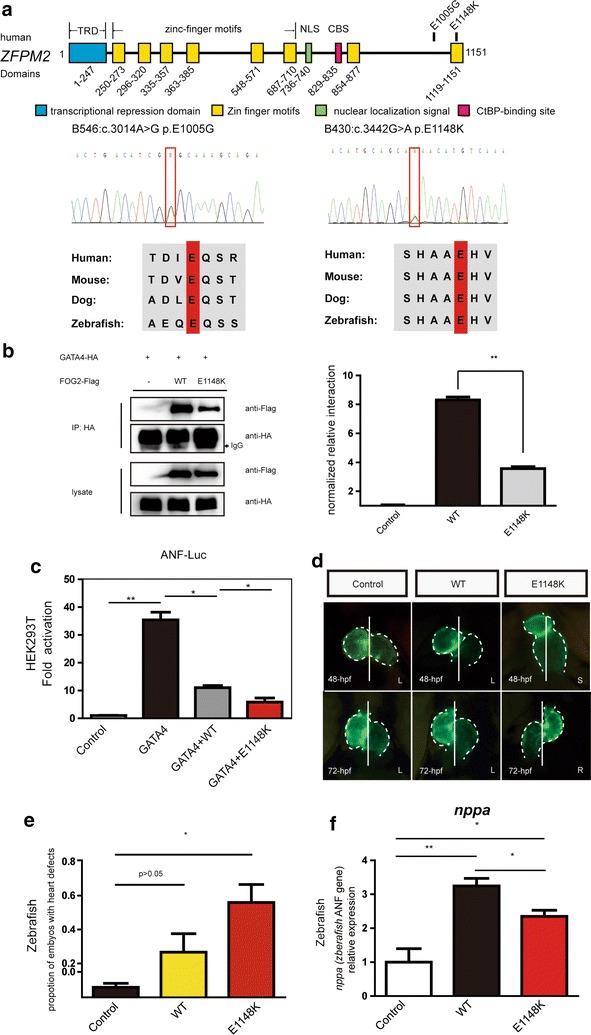Fig. 2.

The variant of ZFPM2 attenuated the transcriptional activation of GATA4 and contributed to the cardiac abnormalities in zebrafish. a Diagram of the human ZFPM2/FOG2 protein domain with the location of its variants identified. The eight zinc-finger motifs (ZNF) are represented by yellow boxes. The nuclear localization signal (NLS) is indicated by a green box. The putative CtBP-binding site (CBS) is represented by a pink box. The N-terminal transcriptional repression domain (TRD) is indicated by a blue box. E1148 K found in B430 is located at the eighth Zinc-finger domain, and E1005G found in B548 is located in the seventh and eighth domains. Sanger sequencing shows the variant in the red frame. Both are conserved in human, mouse, dog and zebrafish. The amino acid residue altered by the mutation is shown in the red box. b Co-immunoprecipitation assays in HEK293T cells revealed that the E1148 K variant significantly damaged the interaction between ZFPM2 and GATA4 on the western blot. The semi-quantitative analysis of the western blot results shows that the E1148 K mutant ZFPM2 protein significantly disrupted the interaction with GATA4 compared to the wild-type ZFPM2 protein. The experiment was repeated three times. (p < 0.05 *, p < 0.01 **) c Luciferase reported gene assays were performed. The result revealed that the wild-type ZFPM2 protein could inhibit the transcriptional activation of GATA4 on the promoter of ANF. Furthermore, E1148 K inhibited the transcriptional activation of the GATA4 on the ANF promoter significantly more than the WT. Experiments were performed in triplicate, and the mean and standard deviations are shown. (*p < 0.05 and **p < 0.01). d Overexpression of the mutant ZFPM2 protein (E1148 K) contributes to the abnormal cardiac morphogenesis in the zebrafish embryos. In the control and wild-type human ZFPM2 mRNA injection groups, the embryos show normal cardiac left–right asymmetry at 48 and 72 hpf. The normal cardiac left–right asymmetry is “left (L)”: the ventricle is on the left side of the midline, and the atrium is on the right side. However, in the mutant mRNA injection group, the embryos showed the “right (R)” or “straight (S)” abnormal left–right asymmetry. e In each group, the cardiac morphogenesis of fifty embryos (n = 50) was analyzed. The number of embryos with cardiac defects, including size, left–right asymmetry, looping and pericardialites, was counted. The proportion of embryos with cardiac defects in the mutant human ZFPM2 protein (E1148 K) injection group is significantly higher than that in the other two groups. Three independent experiments were performed. (*p < 0.05 and **p < 0.01). f The nppa (zebrafish ANF gene) mRNA level in the embryos that received the E1148 K mutant human ZFPM2 mRNA injection is lower than that in the wild-type human ZFPM2 mRNA injection group. The mean and standard deviations are shown. Experiments were performed in triplicate. (*p < 0.05 and **p < 0.01)
